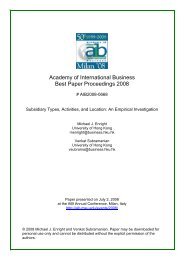AIB 2012 Conference Proceedings - Academy of International ...
AIB 2012 Conference Proceedings - Academy of International ...
AIB 2012 Conference Proceedings - Academy of International ...
You also want an ePaper? Increase the reach of your titles
YUMPU automatically turns print PDFs into web optimized ePapers that Google loves.
TUESDAY<br />
Cross-National Distance and Insidership in Networks:Japanese MNEs' Ownership Decisions on Their Overseas<br />
Subsidiaries<br />
Megan (Min) Zhang, University <strong>of</strong> Western Ontario<br />
Combining country specificity with network specificity, this study reinvestigates the controversial question <strong>of</strong><br />
MNEs' equity ownership decisions on their overseas subsidiaries. When studying ownership as a formal structure<br />
<strong>of</strong> overseas subsidiaries, most prior studies were only concerned with the influence <strong>of</strong> cross-national distance,<br />
but did not examine whether networks as informal structures <strong>of</strong> firms affect the decision-making. Moreover,<br />
most prior studies adopted aggregated constructs, time-invariant measures, and single level analyses, and<br />
thereby failed to capture the complexity <strong>of</strong> the phenomenon further. Some <strong>of</strong> them even resulted in mutually<br />
conflicting conclusions. To address these issues, the study first applies multidimensional and longitudinal<br />
measures to the investigation, and thereby captures the diverse influences <strong>of</strong> cross-national distance on MNE's<br />
ownership decisions. Moreover, the study takes inter-organizational collaborations into account, and thereby<br />
empirically addresses the insidership in business networks and their influences on ownership decisions. Finally,<br />
the study identifies that the insidership in networks alleviates cross-national distance's influences on ownership<br />
decisions. To capture this cross-level interaction, the study adopts Hierarchical Linear Modeling approach.<br />
Future research and implications for practice are also discussed. (For more information, please contact: Megan<br />
(Min) Zhang, University <strong>of</strong> Western Ontario, Canada: mzhang.phd@ivey.ca)<br />
The Impact <strong>of</strong> MNEs' Competitive Network Positions on the Intensity <strong>of</strong> Competitors' Actions: The Moderating<br />
Role <strong>of</strong> Competitive Action Types<br />
Yu-Ching Chiao, National Chung Hsing University<br />
Keng-Hsiang Cheng, National Chung Hsing University<br />
There has been little empirical research discussing competitive dynamics by considering competitive networks<br />
and how firms' positions in a competitive network impact competitors' actions. Using the awarenessmotivation-capability<br />
(AMC) perspective, this study explores how a focal firm's structural hole and outward<br />
centrality in a competitive network affects its intensity <strong>of</strong> competitors' actions, and the moderate effect <strong>of</strong><br />
competitive action types between competitive network positions and the intensity <strong>of</strong> competitors' actions.<br />
Examining a sample <strong>of</strong> top 20 container shipping multinational enterprises (MNEs) by collecting 2,984<br />
competitive actions <strong>of</strong> 682 global competitive interactions news from Cyber Shipping Guide (CSG), we found<br />
that a firm with higher outward centrality <strong>of</strong> competition or higher structural hole in a competitive network is<br />
subject to less threat from its competitors' actions. The number <strong>of</strong> strategic actions taken by a focal firm will<br />
strengthen the negative relationship between structural hole <strong>of</strong> competition and intensity <strong>of</strong> competitors'<br />
actions. Moreover, the number <strong>of</strong> tactic actions <strong>of</strong> a focal firm will weaken the negative relationship between<br />
outward centrality <strong>of</strong> competition and intensity <strong>of</strong> competitors' actions. The implications <strong>of</strong> these findings for<br />
research and practice are also discussed. (For more information, please contact: Keng-Hsiang Cheng, National<br />
Chung Hsing University, Taiwan: kenghsiang.c@gmail.com)<br />
The Private and Common Benefits <strong>of</strong> Spanning Structural Holes within the MNE Network<br />
Lisa Katarina Gaerber, Copenhagen Business School<br />
Torben Pedersen, Copenhagen Business School<br />
Shalini Rogbeer , WU Wien<br />
It is well established that spanning structural holes creates private benefits through innovation. However, the<br />
extent to which other network members pr<strong>of</strong>it from spanning structural holes remains unclear. This research<br />
considers how subunits that span structural holes within the MNE network reap private benefits in terms <strong>of</strong><br />
innovation, as well as contribute to the common network benefits through knowledge outflows. Acknowledging<br />
that a direct relationship between knowledge sharing and innovation exists, we use a 3SLS model to elucidate<br />
<strong>AIB</strong> <strong>2012</strong> <strong>Conference</strong> <strong>Proceedings</strong><br />
Page 228

















